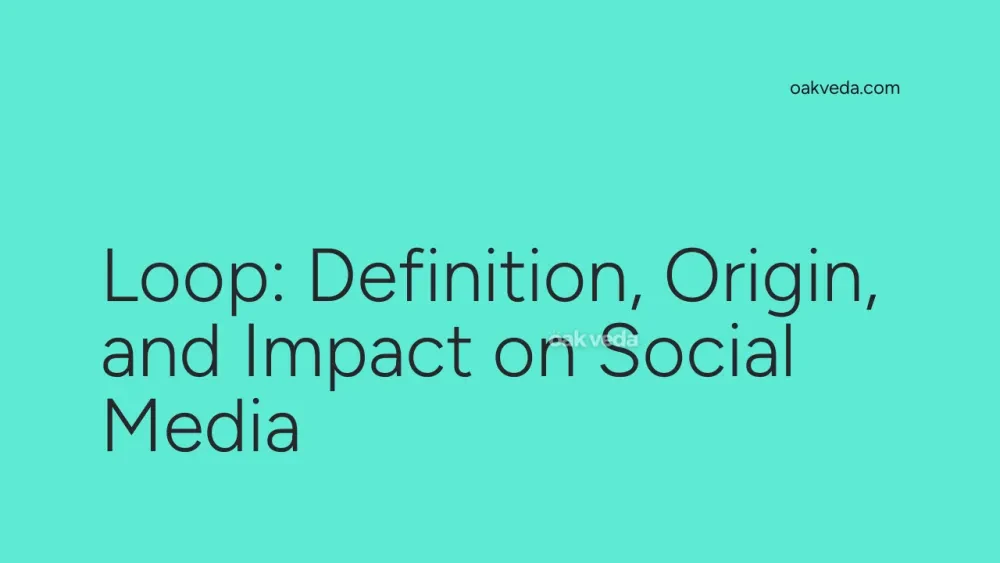
What is a Loop?
A loop in social media refers to a video that automatically replays itself after reaching its end. This feature, primarily associated with platforms like TikTok and Instagram Reels, allows viewers to watch content repeatedly without manually restarting it. Loops are designed to enhance user engagement and provide a seamless viewing experience for short-form video content.
Origin and Development of Loops
The concept of looping videos gained prominence with the rise of short-form video platforms. TikTok, formerly known as Musical.ly, popularized the loop feature, which was later adopted by Instagram Reels and other competing platforms. The development of loops was driven by the need to keep users engaged with content for longer periods and to accommodate the fast-paced nature of social media consumption.
How Loops Work
When a video is set to loop, it automatically restarts from the beginning as soon as it ends. This continuous playback continues until the viewer actively chooses to stop watching or move on to another video. The seamless transition between the end and the beginning of the video creates a hypnotic effect, encouraging viewers to watch the content multiple times.
Types of Loops
- Standard Loops: Basic videos that replay automatically.
- Perfect Loops: Videos crafted to transition seamlessly from end to beginning, creating an illusion of infinite playback.
- Counted Loops: Some platforms display the number of times a video has looped for an individual viewer.
Popular Examples of Loops
Loops have become a creative tool for content creators across various genres:
- Dance challenges where performers repeat a specific move
- Optical illusions that appear different with each loop
- Short comedy skits with unexpected endings that encourage rewatching
- Educational content that benefits from repetition, such as language learning or cooking techniques
Impact of Loops on Social Media Culture
Loops have significantly influenced social media culture in several ways:
- Attention Economy: Loops cater to shorter attention spans, allowing creators to pack more impact into brief moments.
- Viral Potential: The repetitive nature of loops can make content more memorable and shareable.
- Engagement Metrics: Each loop counts as a view, potentially inflating view counts and altering engagement metrics.
- Creative Challenges: Creators are pushed to develop content that remains interesting even after multiple views.
How Brands and Influencers Use Loops
Brands and influencers have embraced loops as a powerful marketing tool:
- Product Showcases: Demonstrating product features or uses in a repeating format.
- Brand Awareness: Creating catchy, loopable content to increase brand recall.
- Challenges: Initiating viral challenges that encourage user-generated content.
- Tutorial Snippets: Offering quick, repeatable how-to content.
Future Trends Related to Loops
As social media continues to evolve, we can expect to see:
- Advanced Loop Analytics: More detailed insights into how users interact with looped content.
- AI-Generated Loops: Artificial intelligence creating perfect loops from longer videos.
- Interactive Loops: Loops that change slightly with each iteration based on user interaction.
- Cross-Platform Integration: Standardization of loop features across various social media platforms.
FAQs about Loops
Are loops only available on TikTok?
No, while TikTok popularized loops, they are now available on other platforms like Instagram Reels and YouTube Shorts.
Do loops affect a video's performance metrics?
Yes, loops can significantly impact view counts and engagement rates, as each replay is typically counted as a new view.
Can any video be turned into a loop?
While most short-form videos automatically loop on supporting platforms, creating a "perfect loop" requires careful planning and editing.
How long can a looped video be?
The length varies by platform, but most looped videos are between 3 to 60 seconds long.
Do loops help with algorithm visibility?
Yes, videos that users watch on loop are often favored by platform algorithms, potentially increasing their visibility.
Conclusion
Loops have become an integral part of the social media landscape, reshaping how content is created, consumed, and shared. As a powerful tool for engagement, loops offer creators and brands new ways to capture attention in an increasingly crowded digital space. Understanding and leveraging loops effectively can significantly enhance social media strategies and content performance. As technology and user preferences continue to evolve, loops are likely to remain a key feature in the world of short-form video content, driving innovation and creativity in the social media sphere.
You may be interested in:
- CPC (Cost-Per-Click): Definition, Origin, and Impact
- Koji: Definition, Origin, and Impact on Social Media
- IMO: Definition, Origin, and Impact on Social Media
- Community Manager: Definition, Origin, and Impact
- Social Listening: Definition, Origin, and Impact
- Altered My Brain Chemistry: Definition, Origin, and Impact

